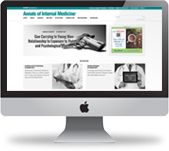Big changes come from many small steps
ACP's Chair of the Board of Regents details the possibilities of advocating to advance health and health care delivery in the United States.
As I enter the final few months of my term as Chair of ACP's Board of Regents, I cannot help but reflect on the fact that this year marks over two decades of active involvement in the College for me. Twenty-two years ago, as a young(er) physician attending his first ACP Leadership Day in Washington, D.C., I became enamored of the idea that a group of physicians, walking the halls of Congress, could work for the betterment of our patients and our profession.
With the benefit of hindsight, I realize that may come across as a bit naive. But I didn't feel that way at the time. And in all honesty, even as a more seasoned physician, I remain optimistic about the possibilities of advocating to advance health and health care delivery in this country.
From time to time, people ask me why I became so involved with the College. There are a host of reasons. That first Leadership Day experience occurred only months after I had opened my own independent primary care practice. I remember in the early days of my career the need to choose a level of service and CPT code for my patient visits. No one ever taught me that before. I hated it.
I was presented with a confusing coding rubric that made no sense, didn't seem to apply to my patients (i.e., those with multiple chronic complex illnesses needing longitudinal care), was impossible to remember, and diverted my energy from what really mattered (the patient). I wanted to speak to the person in charge of that! What was more, the RVU system forced me to come face to face with the relative undervaluation of nonprocedural services in a way I never had before. I wanted to speak to the person in charge of that also! I told myself I could either bottle up my frustration or, instead, roll up my sleeves and channel this energy in a more productive way.
Around the same time, the College was really beginning to champion the cause of the uninsured. I would say that achieving universal access to care, solving the E/M documentation and valuation problem, and tackling the dreaded sustainable growth rate (SGR) formula comprised the three-legged stool of my ACP origin story. That's the elevator speech anyway.
It was therefore a big day for me and my fellow physicians in 2015 when Congress finally eliminated the SGR, the clunky and misguided formula that pegged physician payment to the overall growth of health care spending, which caused large, negative adjustments in physician reimbursement year after year. The vote on the Medicare Access and CHIP Reauthorization Act (MACRA) may have been over in a matter of minutes, but it had taken a decade and a half of legwork by our members, by our staff, and in fact by physicians and staff in every specialty society in the country to get to that moment.
Why am I bringing up a policy issue old enough that many of you reading this column likely (hopefully) have no recollection of it? One reason is simply to make a point that advocacy is effective if you stick with it long enough. But the other lesson to take from this is that progress comes slowly, and in fits and starts. Eliminating the SGR was an important chapter toward a conclusion we have yet to reach. The current iteration of the SGR dilemma is a Physician Fee Schedule that fails to keep up with inflation and a Merit-based Incentive Payment System (MIPS) that is too cumbersome for doctors to use meaningfully. These problems are a strong focus of ACP's current advocacy and can and in fact must be solved for our profession to advance.
Perseverance is a universal part of the human condition, told through mythological tales such as the story of Hercules, who endeavored to complete 12 seemingly implausible labors, and continuing all the way up through real-life struggles such as the modern-day Civil Rights Movement. Another classic example is Virgil's “The Aeneid,” whose protagonist's journey represents an extraordinary testament to perseverance under impossible circumstances but ultimately leads to the founding of Roman civilization. The Romans understood a thing or two about long journeys. After all, the English word “mile” comes from the Roman “mille passus,” a thousand paces measured by every other step (i.e., 2,000 steps).
It can often be difficult to grant yourself the privilege of reflecting on the small, at times imperceptible actions that lead to change. A stone cutter may repeatedly strike a rock with seemingly no effect, say 100 times with no discernable headway, but on the 101st strike, the stone cleaves in half. Progress occurs in steps often too small to be noticed.
There was a time when we physicians could not perform a comprehensive physical examination on a Medicare patient and be reimbursed for it. Shocking, I know. That all changed in 2005 when lawmakers ceded to physician advocacy and allowed for a single physical examination to be performed upon enrollment in the Medicare program. Six years later, the Annual Wellness Visit was born and became an indispensable part of caring for older adults. In 2013, recognizing the extra work involved when patients transition from an inpatient setting to an outpatient setting, the Transitional Care Management codes were developed. Use of these codes has now been shown to reduce readmission rates and lower overall health care costs.
In 2020, with the onset of the COVID-19 pandemic, physicians were finally able to achieve what they had been requesting for decades: the ability to care for patients via telemedicine. And this year, telemedicine also means telephone visits. In 2021, one of the problems I originally joined ACP to help fix took a giant leap forward when the RVU value of the E/M codes increased by some 30% and the complicated documentation guidelines were dramatically simplified for both inpatient and outpatient visits. Most recently, in 2024, the G2211 code was introduced to recognize the longitudinal care that physicians, especially internal medicine physicians, provide to patients.
There are also a host of newer payment models, both pilots and established programs, that now provide additional reimbursement for quality care. And let's not forget that while the rate of uninsured people in this country is still a regrettable 8%, the overall number has been cut in half from 50 million only 15 years ago thanks to the passage and subsequent strengthening of the Affordable Care Act. And all of this didn't just happen. It took years of tireless advocacy.
Each event, each legislative victory, each helpful Medicare rule, represents a small step forward. But looking back, I feel that even an objective observer would grant that we have come a far distance. I am not saying the journey is complete. Not by a long stretch. High levels of physician burnout and a declining interest in nonprocedural specialties remain major challenges, for instance. But imagine where we would be if we suddenly wiped away all these gains.
There is one thing I feel certain of: I am glad that years ago, at the beginning of my career, I chose not to sit idle, frustrated by the state of things and by how big and utterly impossible it might seem to fix anything, let alone everything, that is wrong with our health care system. I am glad I chose to work with a dedicated group of fellow physicians and professionals at the American College of Physicians to help make a difference. With all of us working together, I know the next thousand paces, and the thousand after that, will be that much easier to achieve.




